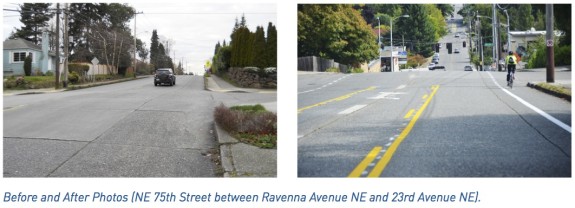 The NE 75th Street Road Safety Corridor project (PDF) has been a huge success by every possible measure. The street is safer for everyone, it’s more comfortable for everyone, and everyone is moving more efficiently.
The NE 75th Street Road Safety Corridor project (PDF) has been a huge success by every possible measure. The street is safer for everyone, it’s more comfortable for everyone, and everyone is moving more efficiently.
When I say everyone, I mean everyone. According to a new city report, speeding is down 60 percent and high-end speeding (10 mph or more above the limit) has been nearly eliminated. Yet traffic is moving more smoothly at a consistent speed allowing the average person driving to move through the area in slightly less time than before the changes were implemented.
Making the street safer and adding bike lanes and a center turn lane made NE 75th Street more efficient. No longer does traffic get tied up behind someone trying to make a left turn, and the road screeches to a halt due to a traffic collision way less often than it used to.
And most importantly, fewer neighbors are getting seriously injured or killed.
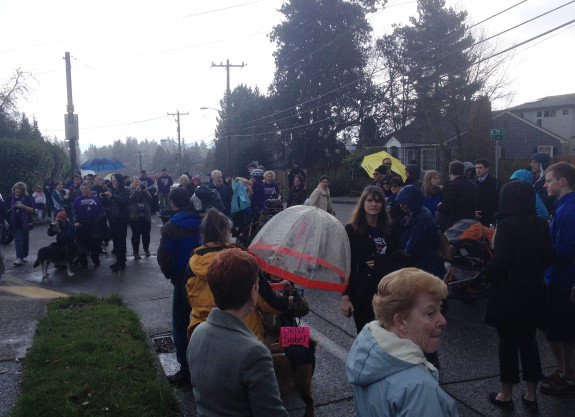
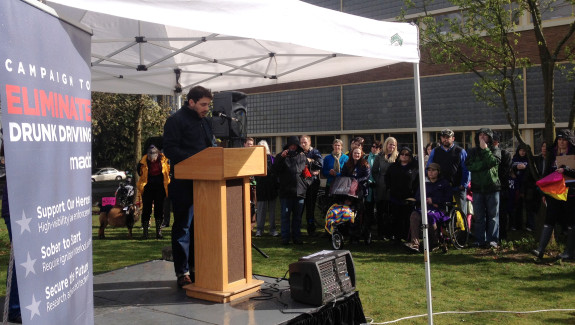
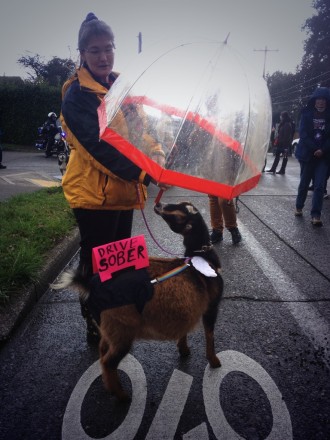
We waited too long to implement this project. The impetus to make the changes came after one of the most devastating instances of traffic violence Seattle has seen in years. Mark Mullen, hammered and behind the wheel of a pickup that should have had an ignition lock system, ran down a family.
Judy and Dennis Schulte were killed. Their daughter-in-law Karina was seriously injured. So was their ten-day-old grandson Elias, who Karina was holding as they walked across the street.
It’s vital to remember that when we look at collision and traffic statistics, we’re talking about the lives of our neighbors, friends and family. The Schulte family deserved better, and we have to take action to prevent anything like that March 2013 collision from happening again.
The Data

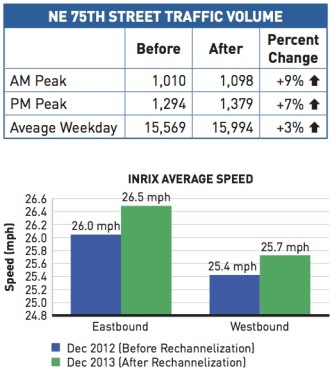 The project area spans a very busy section of NE 75th Street. At 21,300 average daily traffic counts, the section between 15th Ave NE and 25th Ave NE is busier than most Seattle streets. It’s even busier than most of the Rainier Ave sections the city is currently studying for a similar road safety project.
The project area spans a very busy section of NE 75th Street. At 21,300 average daily traffic counts, the section between 15th Ave NE and 25th Ave NE is busier than most Seattle streets. It’s even busier than most of the Rainier Ave sections the city is currently studying for a similar road safety project.
And contrary to concerns and what many people might assume, NE 75th now carries more traffic than it did before, and that traffic now experiences fewer delays. Speeding is down, but average speed is slightly up. Traffic counts (which include people biking) are up 3 percent over the course of a day and almost 10 percent during peak hours.
People are changing their habits and choosing NE 75th over other routes, perhaps because it is more comfortable now. Instead of gunning it to 36 mph or so, then slowing to a stop so someone can make a turn, then gunning it again, traffic moves at a more consistent and safer 26 mph through the whole area, saving time and stress in the end. Plus people who like to drive aggressively and weave between lanes can’t do that anymore, which is a good thing.
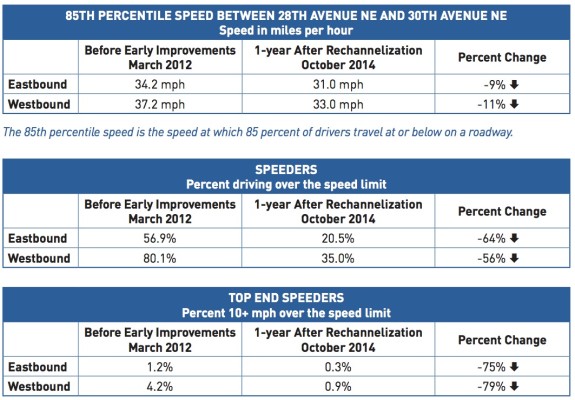 As was the case in previous road safety projects around the city, speeding dropped. But speeding on NE 75th Street did more than drop, it plummeted about 60 percent. And high end speeding (10 mph or more over the limit) was nearly eradicated.
As was the case in previous road safety projects around the city, speeding dropped. But speeding on NE 75th Street did more than drop, it plummeted about 60 percent. And high end speeding (10 mph or more over the limit) was nearly eradicated.
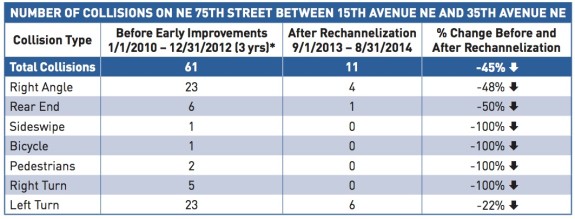
And as expected, collisions of all kinds went way down. Many collision types were eliminated, while others saw declines of 22 – 50 percent. These are people’s lives we’re talking about, so these results are powerful.
They’re so powerful, in fact, that the city should be looking to repeat this success on every dangerous street in the city if it wants to make a serious attempt at reaching Vision Zero. And that’s exactly what the city intends to do.
Mayor Ed Murray’s Move Seattle transportation levy and plan includes funding for 12 – 15 of these project on “all our high-crash streets.” If this plan makes it through the Council and voters approve the levy in November, Seattle really could make a legitimate run at being the first US city to achieve Vision Zero.
The city’s next (and perhaps biggest ever) road safety project challenge is underway right now. Rainier Ave has an even worse safety record than NE 75th did. It also has more foot traffic, more parking demand, more bus service and a higher demand for safe biking space. Rainier is definitely a more difficult project, but the safety benefits are potentially much higher as well. And after looking at this study, the NE 75th Street project should be a guiding light as the city develops designs to finally improve safety and comfort on Rainier Valley’s primary commercial street.








Comments
25 responses to “After NE 75th St safety project: Speeding way down, safety way up, traffic delays … down?”
Thanks Tom! I’m happy to see this information presented so well – thanks very much. I’m even more pleased that the information shows that the project had a huge positive effect.
In the future, I’d like to reference this post when people disagree about the effects of safety projects such as this. Can I assume that you’ve already considered all the “counter-arguments”, and proactively addressed them via the data elements included? If not, I can make sure to set this information in context when referenced.
Thanks for all you do! You’re making a difference in our city and our lives.
Phil
Minor note: the last table “number of collisions” compares 3 years to 1 year. However, the percentages seem to be adjusted accordingly.
This is good news. What is seldom reported about “speeding” is that speeding almost never gives you much of an advantage. Perhaps a few seconds here and a few seconds there. It’s never very much. The only times excessive speed will gain you anything is if you are going over a distance of many miles. Speeding in Texas will gain you *some* time. Local speeding more often than not does not gain you much of anything except using more fuel. It hardly ever saves you an appreciable amount of time. The thing that always amused me when I drove was people who would speed and weave around you only to be stopped at the same signal that you were waiting for.
True but of course many people don’t behave logically when they drive.
Hitting the gas on 85th to make almost any one of the lights, east to west, can save you minutes. Those lights are terrible…
I’d like to see some real proof of this and not just what you “feel.” The only difference speed makes is if you are going on a trip of over 100 miles. In town speeding saves you nothing. And makes you more dangerous to everyone around you.
note that “law abider” (who no doubt chooses the brakes instead of the accelerator when the light turns yellow) is talking about hitting the lights. While speeding down the straightaway will only save a few seconds, if one has ever been a pedestrian, one is painfully aware of how much time one can spend waiting for lights. At least drivers will often get lucky and come upon a light that is already green, while in far too many places a pedestrian, traveling parallel to that same green light, will have a don’t walk signal and will have to press the beg button and wait for the next cycle.
The yellow/amber light is there to transition so that if you are going through an intersection you can do so without fear of a possible collision with another vehicle. If in going through an intersection you are still going through the intersection and the light turns red you *have* run the light and if the police see you doing this you have the possibility of being sited (and getting a $198 fine in Seattle.) It’s very likely that if you did run the light it was because you were speeding and going too fast.
Joseph: minor detail, here. According to RCW
http://apps.leg.wa.gov/rcw/default.aspx?cite=46.61&full=true#46.61.055
we can enter the intersection during an amber light and it is legal if it turns red while we’re still clearing the intersection. The keywords in the RCW para 2a are “shall not enter”. In other words, if the light is red, you shall not enter. But if you’re already in, you’re ok. (There are other RCWs for blocking an intersection so, once in, you can’t just sit there :)
I’d like to add: it’s a great benefit to us to have the law written this way. One, as a bicyclist, it isn’t uncommon to finish going through an intersection after the light turns red. The amber timing is for 25-30 mph travel and I might be pedaling at 15mph. I’m not going to make it!
Another reason is easier to appreciate if the law were opposite. If it were illegal to be in the intersection when the light turns red, it would encourage drivers to accelerate when they see an amber light. This is completely the wrong message as the most dangerous place to go fast is in an intersection and we should encourage people to slow down (or at most maintain speed), not speed up when they see an amber light.
Thank you for the great information, Tom. Like PSJ, I will use this post as a supporting reference when arguing for the road safety for everyone. I just with the media like the Seattle Times would pick it up… Yes, dream on…
I really wish they would extend the bike land and merge traffic down to one lane right at 12th Ave NE heading East on 75th Ave NE. Both as a biker and driver it’s confusing to make the lanes merge halfway through that block. There used to be two lanes and all the drivers can’t figure it out, they are still trying to stay in two lanes, putting all the traffic that wants to turn right on 15th Ave NE right in the bike lane.
This is an area where, I think, the traffic law is vague. The law clearly states that, when making a right turn, you should move your vehicle as far to the right as possible, while staying on the pavement. One interpretation would be to merge into the bike lane before making the turn.
From my point of view, this is actually pretty desirable. Assuming the driver looks when changing lanes, this avoids the right-hook collision. Even if he doesn’t look, it would be much easier to avoid getting hit by a driver merging into the bike lane than avoiding a right hook.
The negative of merging into the bike lane is that it blocks the bike lane. (Could I have said anything more obvious :) That might be ok if it’s just one car turning right and you would have to wait anyway. But it’s questionable if there are a whole string of cars turning. Maybe some special striping could show when it’s ok for cars to merge (maybe that already exists and is ignored).
I agree, I think it’s OK right at the light for right turning drivers to move over there and take a free right, but what’s happening is the lanes merge in the middle of the block and a lot of drivers are just ignoring it or getting confused, because it didn’t used to be that way. If they extended the marked bike lane all the way West to 12th and had one lane of traffic there as well it would work better for both drivers and bikers. It also would eliminate people driving on 12th from taking a free right during a red directly into what becomes the bike lane a half a block later on 75th. It’s just weird for the bike lane to start in the middle of the block and not at the major intersection.
I think one of the things that makes it more confusing is that instead of clearly defined lanes ending the merge actually forces cars in the left lane to move to the right.
[…] speeding (10+ mph over the limit) by up to 70% and reduced crashes by 45%. And at the same time, traffic volume actually increased without slowing travel […]
This is a great project, and somewhat unusual. Most similar projects are “road diets” where a four lane road is converted to a three lane road. Drivers assume that this will make traffic terrible, but it doesn’t (four lanes are only faster than three if there is a really long distance between turns).
But this project is different. This is a conversion from a very wide two lane road (with parking I assume) to a three lane road without parking. This is a great example of something that makes sense in lots of places. For example, 5th NE, between Northgate Way and 130th (where a pedestrian fatality occurred) is more than ready for this change. That road is inherently dangerous. It is really wide, and the parking lane is hardly ever used. It essentially is a four lane road, but with even more flexibility (really wide lanes). It has all the dangers of a four lane road and then some.
Roosevelt Way, through Maple Leaf, could use the same treatment. That road isn’t as dangerous. The city has done a good job slowing people down (at least at the top of the hill). But it is still a willy-nilly, anarchic road design (two wide lanes). Converting it to three lanes would be much better, even if it takes away a parking lane. There are so many areas where the city can (and probably will) improve both road safety as well as traffic flow. Slow and steady just makes a lot of sense in the city (for everyone).
How do people fee about having a bike lane with a 3 lane (1 each way + center) or not having a bike lane?
I’m finding I like the 3 lane designs better and better without a bike lane. As everyone knows, bike lanes next to car doors are useless over about 10mph. Having a 3-lane design allows me to fully take the vehicle lane, knowing that drivers can use the center lane, if needed, to get around me. No more trying to squeeze me into the parked cars.
To accommodate all levels of cyclists, we may still desire to have a bike lane on the flat or downhill in the 3-lane design (and, certainly, uphill).
However, adding a completely separated bike way in a 2-lane design is not a solution. I’ve tried out the various separated lanes and find them too scary over about 15mph. So, I don’t use them and ride in the traffic lane. The 3-lane design, it seems, accommodates a wider representation of cycling levels.
There was parking on 75th, and mayoral candidate Ed Murray, before he got on the bike bandwagon, even cited the loss of parking as a reason maybe we should not do it.
Someone pointed out at the time that though it was legal to park, it was so rare to find a car there that it might as well have not been legal, and that maybe candidate Murray ought to get a staffer on researching this kind of thing before he talked about it.
That he seems to have done, to be fair. :)
[…] on the success of the NE 75th Street safety project, the city is heading west to improve safety on more of NE 75th Street and Banner Way […]
[…] traffic volumes have actually increased slightly on 75th since the completion of the project. The Seattle Bike Blog has a nice summary of the findings as […]
[…] his ability to take bold, fast action on safe streets even for complicated projects. We saw this on NE 75th Street and 2nd Ave and even Rainier […]
[…] track for safety improvements, perhaps as part of the Road Safety Corridor program that led the wildly successful remake of nearby NE 75th Street in […]
[…] in 2013 to NE 75th St–that road diet actually managed to vastly decrease speeds while also decreasing overall travel time and collisions. It’s also important to note that just as many drivers used it after the road diet (there was […]
[…] and a center turn lane. This is very similar to the configuration of NE 75th St after a 2014 rechannelization on a short stretch, which did lead to reductions in traffic speed and […]